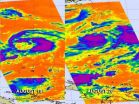(Press-News.org) Botany is plagued by the same problem as the rest of science and society: our ability to generate data quickly and cheaply is surpassing our ability to access and analyze it. In this age of big data, scientists facing too much information rely on computers to search large data sets for patterns that are beyond the capability of humans to recognize—but computers can only interpret data based on the strict set of rules in their programming.
New tools called ontologies provide the rules computers need to transform information into knowledge, by attaching meaning to data, thereby making those data retrievable by computers and more understandable to human beings. Ontology, from the Greek word for the study of being or existence, traditionally falls within the purview of philosophy, but the term is now used by computer and information scientists to describe a strategy for representing knowledge in a consistent fashion. An ontology in this contemporary sense is a description of the types of entities within a given domain and the relationships among them.
A new article in this month's American Journal of Botany by Ramona Walls (New York Botanical Garden) and colleagues describes how scientists build ontologies such as the Plant Ontology (PO) and how these tools can transform plant science by facilitating new ways of gathering and exploring data.
When data from many divergent sources, such as data about some specific plant organ, are associated or "tagged" with particular terms from a single ontology or set of interrelated ontologies, the data become easier to find, and computers can use the logical relationships in the ontologies to correctly combine the information from the different databases. Moreover, computers can also use ontologies to aggregate data associated with the different subclasses or parts of entities.
For example, suppose a researcher is searching online for all examples of gene expression in a leaf. Any botanist performing this search would include experiments that described gene expression in petioles and midribs or in a frond. However, a search engine would not know that it needs to include these terms in its search—unless it was told that a frond is a type of leaf, and that every petiole and every midrib are parts of some leaf. It is this information that ontologies provide.
The article in the American Journal of Botany by Walls and colleagues describes what ontologies are, why they are relevant to plant science, and some of the basic principles of ontology development. It includes an overview of the ontologies that are relevant to botany, with a more detailed description of the PO and the challenges of building an ontology that covers all green plants. The article also describes four keys areas of plant science that could benefit from the use of ontologies: (1) comparative genetics, genomics, phenomics, and development; (2) taxonomy and systematics; (3) semantic applications; and (4) education. Although most of the examples in this article are drawn from plant science, the principles could apply to any group of organisms, and the article should be of interest to zoologists as well.
As genomic and phenomic data become available for more species, many different research groups are embarking on the annotation of their data and images with ontology terms. At the same time, cross-species queries are becoming more common, causing more researchers in plant science to turn to ontologies. Ontology developers are working with the scientists who generate data to make sure ontologies accurately reflect current science, and with database developers and publishers to find ways to make it easier for scientist to associate their data with ontologies.
INFORMATION:
Walls, Ramona L., Balaji Athreya, Laurel Cooper, Justin Elser, Maria A. Gandolfo, Pankaj Jaiswal, Christopher J. Mungall, Justin Preece, Stefan Rensing, Barry Smith, and Dennis W. Stevenson. 2012. Ontologies as integrative tools for plant science. American Journal of Botany 99(8): 1263-1275. DOI: 10.3732/ajb.1200222
The full article in the link mentioned is available for no charge for 30 days following the date of this summary at http://www.amjbot.org/content/99/8/1263.full. After this date, reporters may contact Richard Hund at ajb@botany.org for a copy of the article.
The Botanical Society of America (www.botany.org) is a non-profit membership society with a mission to promote botany, the field of basic science dealing with the study and inquiry into the form, function, development, diversity, reproduction, evolution, and uses of plants and their interactions within the biosphere. It has published the American Journal of Botany (www.amjbot.org) for nearly 100 years. In 2009, the Special Libraries Association named the American Journal of Botany one of the Top 10 Most Influential Journals of the Century in the field of Biology and Medicine.
For further information, please contact the AJB staff at ajb@botany.org.
Information overload in the era of 'big data'
New search tools give scientists better ways of managing data
2012-08-21
ELSE PRESS RELEASES FROM THIS DATE:
Stroke disrupts how brain controls muscle synergies
2012-08-21
CAMBRIDGE, MA -- The simple act of picking up a pencil requires the coordination of dozens of muscles: The eyes and head must turn toward the object as the hand reaches forward and the fingers grasp it. To make this job more manageable, the brain's motor cortex has implemented a system of shortcuts. Instead of controlling each muscle independently, the cortex is believed to activate muscles in groups, known as "muscle synergies." These synergies can be combined in different ways to achieve a wide range of movements.
A new study from MIT, Harvard Medical School and the ...
Nanoparticles added to platelets double internal injury survival rate
2012-08-21
Nanoparticles tailored to latch onto blood platelets rapidly create healthy clots and nearly double the survival rate in the vital first hour after injury, new research shows.
"We knew an injection of these nanoparticles stopped bleeding faster, but now we know the bleeding is stopped in time to increase survival following trauma," said Erin Lavik, a professor of biomedical engineering at Case Western Reserve University and leader of the effort.
The researchers are developing synthetic platelets that first responders and battlefield medics could carry with them to stabilize ...
Breast density does not influence breast cancer death among breast cancer patients
2012-08-21
The risk of dying from breast cancer was not related to high mammographic breast density in breast cancer patients, according to a study published August 20 in the Journal of the National Cancer Institute.
One of the strongest risk factors for non-familial breast cancer is elevated mammographic breast density. While women with elevated mammographic breast density have a higher risk of developing breast cancer, it is not established whether a higher density indicates a lower chance of survival in breast cancer patients.
In order to determine if higher mammographic breast ...
NASA satellites capture 3 days of Hurricane Gordon's Atlantic track
2012-08-21
NASA's Terra and Aqua satellite have captured Hurricane Gordon over three days as it neared the Azores Islands in the eastern Atlantic Ocean. Gordon weakened to a tropical storm on August 20.
The Moderate Resolution Imaging Spectroradiometer, or MODIS, is an instrument that flies onboard NASA's Terra and Aqua satellites and provides high-resolution imagery to users. When NASA's Terra satellite flew over Gordon on August 17 at 9:30 a.m. EDT it was a tropical storm and did not have a visible eye. It was followed up by a fly over of NASA's Aqua satellite on August 18 at ...
First evidence discovered of planet's destruction by its star
2012-08-21
The first evidence of a planet's destruction by its aging star has been discovered by an international team of astronomers. The evidence indicates that the missing planet was devoured as the star began expanding into a "red giant" -- the stellar equivalent of advanced age. "A similar fate may await the inner planets in our solar system, when the Sun becomes a red giant and expands all the way out to Earth's orbit some five-billion years from now," said Alexander Wolszczan, Evan Pugh Professor of Astronomy and Astrophysics at Penn State University, who is one of the members ...
NASA watches as Tropical Storm Bolaven develops
2012-08-21
Tropical Storm Bolaven was born over the weekend of August 18-19 in the western North Pacific, and NASA captured infrared satellite imagery of its birth and growth.
NASA's Aqua satellite has been monitoring the birth and progress of Tropical Storm Bolaven in the western North Pacific from Aug 19-20, 2012. The Atmospheric Infrared Sounder (AIRS) instrument has provided infrared satellite imagery that shows the development of colder thunderstorm cloud-top temperatures, that were indicative of strengthening storms. Tropical Storm Bolaven also took more of a rounded shape ...
Infants' avoidance of drop-off reflects specific motor ability, not fear
2012-08-21
Researchers have long studied infants' perceptions of safe and risky ground by observing their willingness to cross a visual cliff, a large drop-off covered with a solid glass surface. In crawling, infants grow more likely to avoid the apparent drop-off, leading researchers to conclude that they have a fear of heights. Now a new study has found that although infants learn to avoid the drop-off while crawling, this knowledge doesn't transfer to walking. This suggests that what infants learn is to perceive the limits of their ability to crawl or walk, not a generalized fear ...
Ethnic and political violence increases children's aggressive behavior
2012-08-21
Ethnic and political violence in the Middle East can increase violence in families, schools, and communities, which can in turn boost children's aggressiveness, especially among 8-year-olds. Those are the findings of a new study that examined children and their parents in the Middle East.
"The study has important implications for understanding how political struggles can spill over into the everyday lives of families and children, and suggests that intervention might be necessary in a number of different social areas to protect children from the adverse impacts of exposure ...
For poorer children, living in a high-cost area hurts development
2012-08-21
Young children in lower-income families who live in high-cost areas don't do as well academically as their counterparts in low-cost areas, according to a new study.
The study, by researchers at Child Trends and the University of California (UCLA), appears in the journal Child Development.
"Among families with incomes below 300 percent of the federal poverty threshold—that's below $66,339 for a family of four—living in a region with a higher cost of living was related to lower academic achievement in first grade," according to Nina Chien, a research scientist with Child ...
Sacrificing sleep to study can lead to academic problems
2012-08-21
Regardless of how much a high school student generally studies each day, if that student sacrifices sleep in order to study more than usual, he or she is more likely to have academic problems the following day. Because students tend to increasingly sacrifice sleep time for studying in the latter years of high school, this negative dynamic becomes more and more prevalent over time.
Those are the findings of a new longitudinal study that focused on daily and yearly variations of students who sacrifice sleep to study. The research was conducted at the University of California, ...
LAST 30 PRESS RELEASES:
An assessment of the antidepressant potential of deramciclane in two animal tests
Pitt and UPMC study finds epigenetic signature of pediatric traumatic brain injury, paves way for precision recovery tools
Brain discovery opens door to earlier detection of metabolic syndrome in women
SwRI-led study provides insight into oscillations in solar flares
Announcing the third cohort of the Hevolution/AFAR new investigator awards in aging biology and geroscience research
GeoFlame VISION: Using AI and satellite imagery to predict future wildfire risk
Nationwide study suggests that water treatment methods may impact the risk of legionnaires’ disease
Oyster larvae on drugs move slowly and are stressed
Targeting a specific brain circuit may help prevent opioid relapse, WSU study finds
Tec-Dara combination offers substantial improvement over standard second-line therapies for relapsed or refractory multiple myeloma
Improving treatment for an autoimmune bleeding condition
Drug reduced need for blood transfusions during hospitalization for non-cardiac surgery
Novel agent ianalumab added to standard therapy extends time to treatment failure in patients with previously treated immune thrombocytopenia
Pirtobrutinib outperforms bendamustine plus rituximab for previously untreated CLL/SLL
Online tracking and privacy on hospital websites
A freely available tool to document wartime destruction
Residential solar panels can raise electricity rates
Scientists use synthetic platelets as ‘Trojan horse’ drug-delivery system
Cooperative Intermolecular Interactions Regulate Supramolecular Polymer Assembly
Korea University researchers develop ultrasensitive method to detect low-frequency cancer mutations
First patient enrolled in GOG-3133/ FRAmework-01 phase 3 study evaluating sofetabart mipitecan (LY4170156), a novel ADC targeting folate receptor alpha (FRα), in recurrent ovarian cancer
Two Hebrew University researchers win prestigious ERC consolidator grants
ERC grant helps to quantify the impact of anthropogenic air pollution particles on climate
Exercise might help improve mobility during aging
New online tool detects drug exposure directly from patient samples
Learn the surprising culprit limiting the abundance of Earth’s largest land animals
Study reveals new ways the brain regulates communication between neurons
Research reveals new hybrid state of matter where solids meet liquids
Researchers develop a new computational tool to understand how genetic interactions impact human traits
Elephants, giraffes and rhinos go where the salt is
[Press-News.org] Information overload in the era of 'big data'New search tools give scientists better ways of managing data



